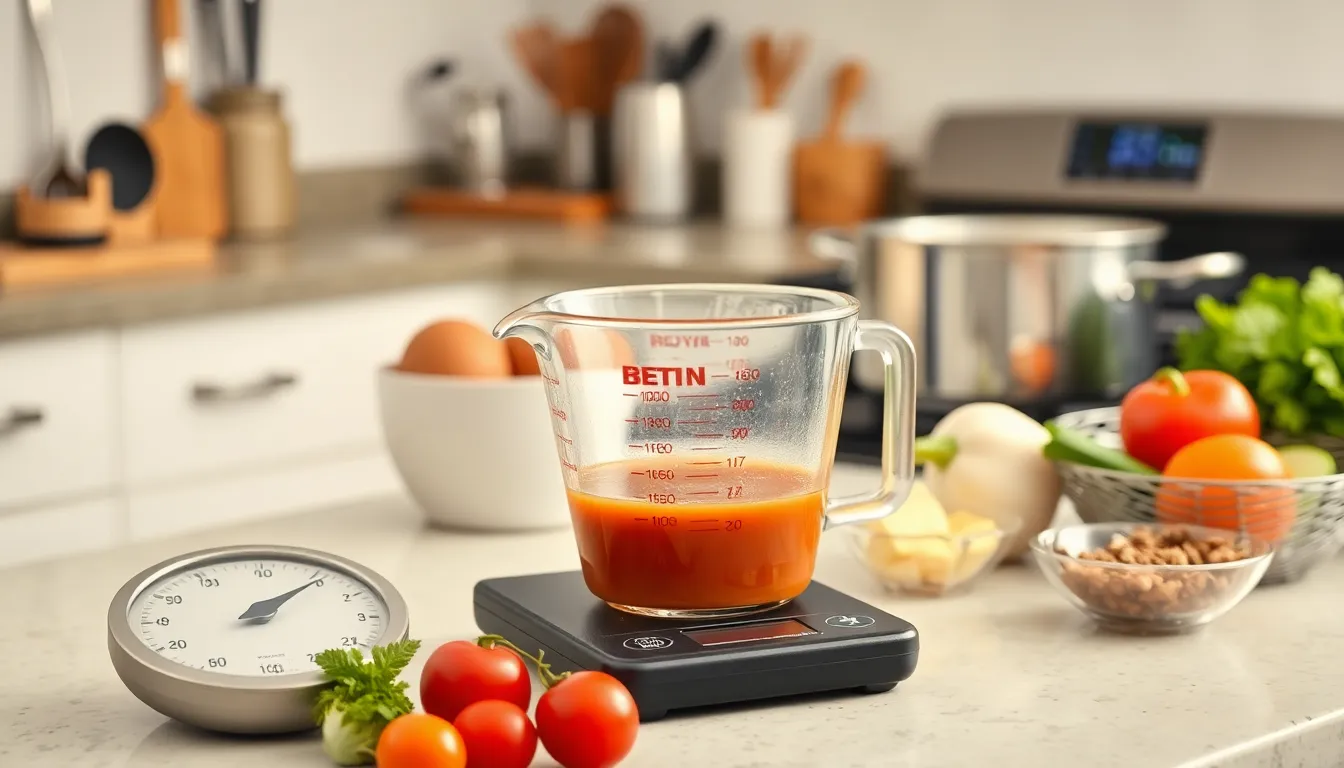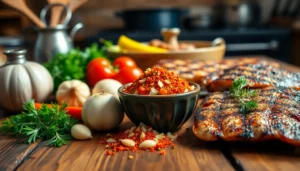Table of Contents
ToggleEver found yourself in a kitchen showdown, staring down a recipe that calls for milliliters while your measuring cups only speak ounces? You’re not alone. Converting between these two measurements can feel like trying to decipher a secret code, but fear not!
Understanding Milliliters and Ounces
Conversions between milliliters and ounces often come up in culinary settings. Knowing the definitions of these units helps clarify any confusion.
What is a Milliliter?
A milliliter is a metric unit of volume. It represents one-thousandth of a liter. Commonly used for liquid measurements, its symbol is mL. Many recipes specify ingredients in milliliters, especially in countries that utilize the metric system. For instance, a typical shot of liquor is about 44 mL. You’ll find that milliliters are used in medicine, cooking, and laboratory settings.
What is an Ounce?
An ounce is a unit of weight and volume in the imperial system. In fluid measurements, it defines a volume equal to approximately 29.57 mL. Fluid ounces are often used in the United States for liquids. Recipes frequently list liquid ingredients in ounces, particularly in the US. For example, a cup contains 8 ounces, translating to about 237 mL. Ounces are commonly found on beverage containers and food packaging, reinforcing their everyday relevance.
Conversion Basics

Conversion between milliliters and ounces is crucial in cooking. Understanding these units simplifies the process of following recipes.
Metric vs. Imperial Measurements
Metric measurements utilize standardized units like milliliters. A milliliter represents one-thousandth of a liter, ideal for precision in cooking. Imperial measurements, on the other hand, use ounces for volume. One fluid ounce equals approximately 29.57 mL. In cooking, these differences can impact ingredient proportions significantly. Countries using the metric system commonly employ milliliters, while the U.S. typically relies on ounces. Navigating these systems eases the cooking process and helps ensure accurate results.
Why Convert Milliliters to Ounces?
Converting milliliters to ounces aids in recipe management. Some recipes use ounces, while others specify milliliters, particularly in international contexts. Understanding equivalencies facilitates ingredient accuracy. Ensuring correct amounts enhances flavor and texture in dishes. For example, knowing that 50 mL converts to 1.69 ounces makes measuring straightforward. Confusion often arises when measurements differ, but converting helps clarify these details. Familiarity with conversions supports culinary skills and enhances recipe outcomes.
How Many Oz is 50 Ml?
Converting 50 milliliters to ounces requires a straightforward calculation. Since one fluid ounce equals approximately 29.57 mL, the conversion from milliliters to ounces can be achieved using this formula:
[ text{Ounces} = frac{text{Milliliters}}{29.57} ]
Thus, calculating for 50 mL results in approximately 1.69 ounces.
Conversion Calculation
To convert 50 mL to oz, apply the formula mentioned. The calculation yields 1.69 oz as the result. For clarity, rounding can simplify the conversion to approximately 1.7 oz. Utilizing this conversion helps in understanding how different measurement systems relate.
Practical Applications of the Conversion
Understanding how to convert 50 mL to ounces holds practical importance in cooking. Many recipes in the U.S. use ounces for liquid ingredients, making this knowledge essential. For instance, when a recipe calls for 1.5 oz of an ingredient, knowing that it equals roughly 44.36 mL aids in accurate measurements. Many cooks benefit from familiarizing themselves with this conversion to enhance precision and improve dish outcomes.
Tips for Accurate Measurement
Accurate measurement is crucial when converting milliliters to ounces. Following some practical tips helps ensure precision in cooking.
Using Conversion Tools
Employing conversion tools enhances measurement accuracy. Various online calculators and apps provide quick conversions from milliliters to ounces. Many of these tools are user-friendly, allowing for rapid results. Users can enter the volume in milliliters, and the output displays the equivalent in ounces instantly. Relying on these tools minimizes human error and streamlines the cooking process. Additionally, digital kitchen scales can offer precise measurements for equivalent volumes, making culinary tasks smoother.
Common Measuring Devices
Utilizing common measuring devices improves consistency in recipe execution. Liquid measuring cups are ideal for measuring larger volumes, typically marked with both milliliters and ounces. Graduated cylinders also provide accuracy for smaller quantities. For precise measurements of small liquids, medicine droppers or syringes work well. Tablespoons and teaspoons often convert to ounces too, which can assist in liquid measurements. Ensuring these devices are clean and properly calibrated prevents discrepancies in amount measured.
Understanding the conversion from milliliters to ounces is essential for anyone looking to enhance their cooking skills. With 50 milliliters equating to approximately 1.69 ounces, cooks can confidently measure ingredients for recipes that use different units. This knowledge streamlines the cooking process and ensures accuracy in measurements. Utilizing conversion tools and proper measuring devices further aids in achieving consistent results. By mastering these conversions, cooks can elevate their culinary creations and enjoy a more seamless cooking experience.




